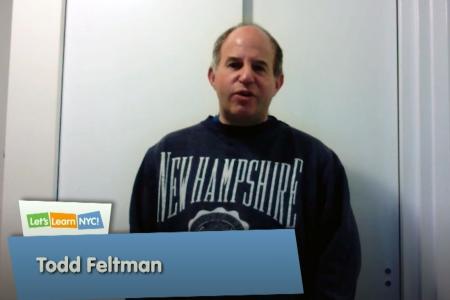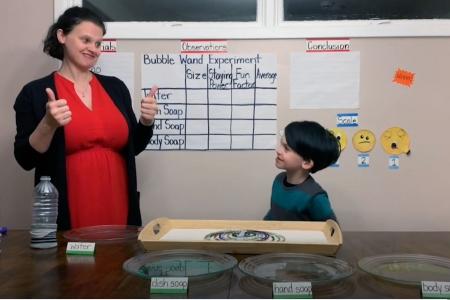NYC teachers’ lessons featured in PBS program

Manhattan universal literacy coach Todd Feltman during one of his lessons broadcast on PBS’ “Let’s Learn NYC!” program.

Cassondra Easterling, a coach at PS/MS 46 in Harlem, conducts a science experiment with one of her children.
“I’m going to give you 30 seconds to think and to share out your ideas” about staying strong and healthy, says Todd Feltman, a universal literacy coach at PS 36 in Manhattan. “I can’t wait to hear your responses.”
It is just the kind of engaging, interactive lesson you’d expect to see in a New York City public school classroom, except for one thing: Feltman is alone in his home, addressing a camera for a lesson that will be broadcast on the Public Broadcasting Service (PBS).
The city Department of Education, in partnership with the WNET Group, launched “Let’s Learn NYC!” in early May. The one-hour program, which is funded by a $250,000 grant from the nonprofit Fund for Public Schools, is aimed at children in 3K through 2nd grade and airs at 11 a.m. and noon every weekday. Episodes are also available to stream online.
Each episode features a series of lessons designed and recorded by universal literacy coaches who volunteered to participate. New York City public school teachers have filmed themselves drawing shapes, reading aloud and doing art projects with household materials. Cassondra Easterling, a coach at PS/MS 46 in Manhattan’s Harlem, even enlisted her two children to serve as test subjects in a science experiment: Wearing blindfolds, they tasted “mystery items” that Easterling encouraged viewers to find at home for their own taste tests.
“As the parent of a 6-year-old, I jumped on board with the project because it’s an opportunity to help families,” says Carissa Berliner, a coach at PS 182 in Jamaica, Queens. “It’s hard for little ones to work on a computer — parents have to do a lot of the reading and explaining. This is minimal work for parents and hopefully, students will be engaged enough to pick up some activities and internalize the learning.”
Teachers are making sure their lessons use simple materials children can find at home and include components that mirror familiar classroom lessons.
Berliner hopes the program will be a resource for her fellow educators, too.
“This is also a tool for teachers to get ideas on how to engage students remotely,” she says.